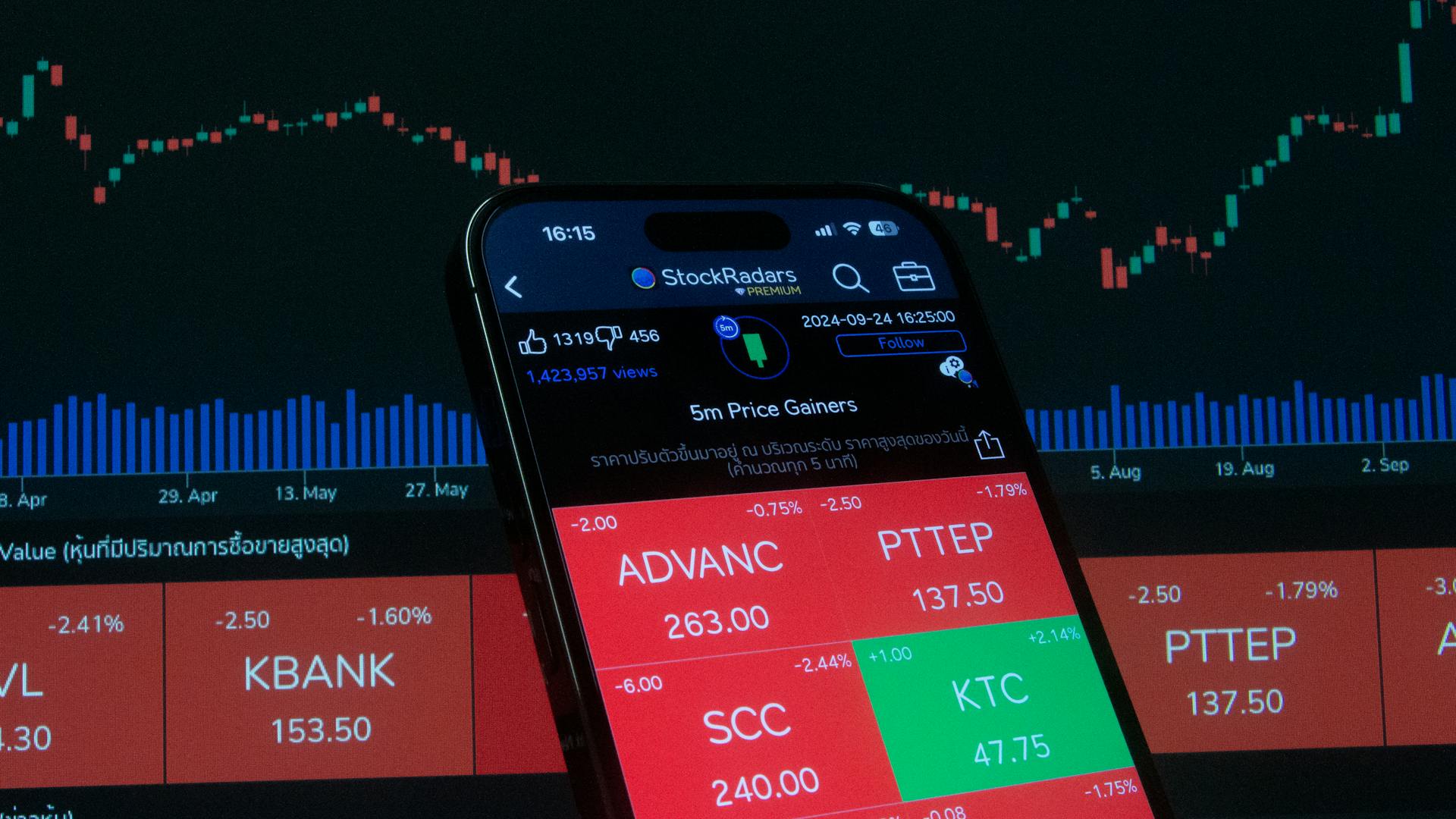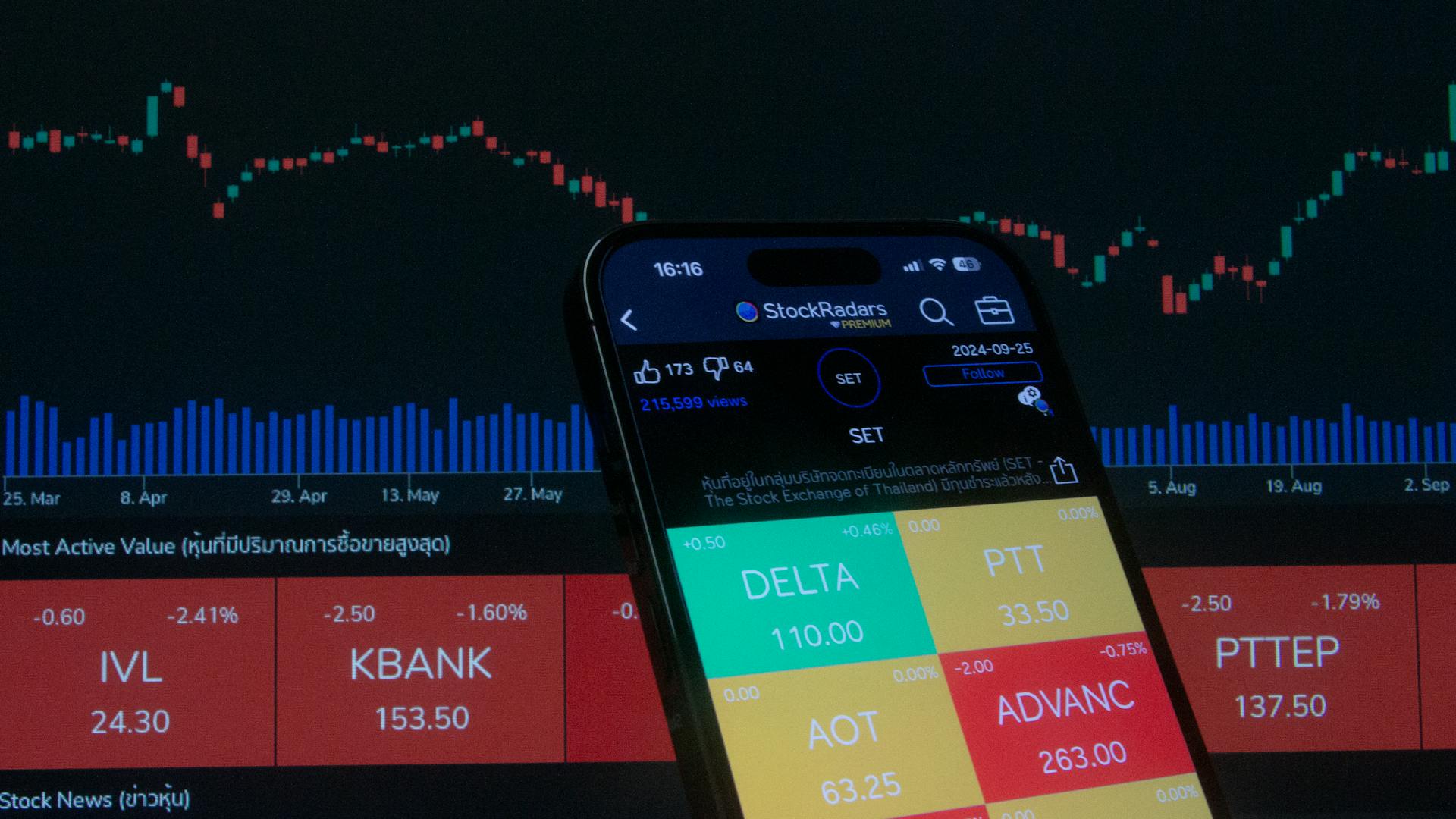
To find preferred stock that fits your investment portfolio, start by researching publicly traded companies that issue preferred stock. You can check the stock exchanges, such as the New York Stock Exchange (NYSE) or NASDAQ, for a list of companies that have issued preferred stock.
Look for companies with a strong financial history and a stable business model. This will help you assess the likelihood of the company paying dividends on the preferred stock. For example, companies like Johnson & Johnson and Procter & Gamble are known for their stable financials.
Consider the type of preferred stock you're interested in, such as cumulative or non-cumulative. Cumulative preferred stock requires the company to make up any missed dividend payments, while non-cumulative preferred stock does not.
Recommended read: Paramount Class B Stock
What is Stock?
Stock is a type of investment that represents ownership in a public company. Preferred stock and common stock are two types of stock that offer partial ownership in a public company.
Worth a look: B Riley Preferred Stock

Preferred stock operates more like bonds than common shares, offering guaranteed dividends that depend on interest rates rather than corporate performance. This means that preferred stock holders get a regular income stream, but they don't have the same level of control as common stock holders.
Companies issue preferred stock for various financial and regulatory reasons, such as raising money without taking on debt that might impact their credit rating. By issuing preferred stock, companies can avoid debt limits imposed by regulations.
Preferred stock trades on the stock market right alongside common stock, making it accessible to investors.
Curious to learn more? Check out: Preferred Stock Holders
Stock Exchanges
NYSE ticker symbols for preferred stocks have a unique format, with most having 5 letters in the format: TTTpX, where TTT is the three-letter ticker symbol and X denotes the share class.
The lowercase "p" in the ticker is case sensitive, so be aware of this when searching for preferred stocks.
For example, CpK is the preferred issue for "Citigroup ADRs of 6.875% Fixed Rate/Floating Rate Noncumulative Preferred Series K", and CPK is actually "Chesapeake Utilities Corporation".
Intriguing read: Adjustable Rate Preferred Shares
NYSE

The NYSE is a stock exchange with its own unique ticker symbol format. Most NYSE tickers have three letters, but there's a special case for preferred shares.
Preferred stocks on the NYSE have 5-letter tickers in the format TTTpX. The TTT part is the three-letter ticker symbol, and the X denotes the share class of the preferred shares.
The lowercase "p" in the ticker is case sensitive. This means that CpK and CPK are two different things - CpK is a preferred issue, while CPK is a different company altogether.
NYSE tickers for preferred shares are in the format TTTpX, where TTT is the three-letter ticker symbol.
On a similar theme: How Are Stock Speculators Different from Stock Investors
NASDAQ
The NASDAQ is one of the world's largest stock exchanges, and it has its own unique way of representing preferred stock issues.
Preferred stock symbols on the NASDAQ typically have a 5th letter added to the end of the common stock ticker.
This 5th letter usually represents a preferred issue of the stock, and it can be P, O, N, or M, depending on the issue.
For example, LFMD is "LifeMD Inc.", while LFMDP is "LifeMD 8.875 Cumulative Perpetual Pref Shs Series A".
Here's a breakdown of what each of these letters typically represents:
Stock Symbology

Stock Symbology is a crucial aspect of finding preferred stock. Stock symbols, also known as ticker symbols, are unique codes assigned to each publicly traded company.
These symbols are used to identify a company on stock exchanges, such as the NYSE or NASDAQ. A stock symbol is usually a combination of letters, but sometimes it can be a single letter.
For example, the stock symbol for Apple Inc. is AAPL. This symbol is used in stock markets, financial news, and even in online stock trading platforms.
Stock Data
You can get real-time stock data or historical data on preferred shares using our Google Sheets Add-on.
Our Google Sheets Add-on can also be used to look-up historical candlestick data for both NYSE and Nasdaq-issued preferreds.
The format is the same whether you use our Add-on or the Market Data API.
For NYSE-listed preferred stock symbols, you can use either a lowercase p or a hyphen, such as CDRpB or CDR-B.
The p is case sensitive and must be used in lower-case if you need a preferred stock result.
For NASDAQ-listed preferred stock symbols, just use the full 5 letter symbol, such as LFMDP.
Stock Types

There are several types of stock that you should be aware of when searching for preferred stock.
Common stock is the most basic type of stock and gives shareholders voting rights.
Preferred stock, on the other hand, has a higher claim on assets and dividends than common stock, but typically doesn't come with voting rights.
Convertible preferred stock is a type of preferred stock that can be exchanged for a certain number of shares of common stock.
On a similar theme: Does Preferred Stock Have Voting Rights
Core Features of Shares
Preferred stocks are a type of equity investment that holds a higher claim on a company's assets and earnings than common stocks.
In the event of a bankruptcy, preferred shareholders get paid before common shareholders due to their preferential claim on the company's assets.
Preferred stocks pay dividends to shareholders before common stock dividends are issued and have a fixed dividend rate.
The payment from preferred stocks is in the form of a quarterly, monthly, or yearly dividend, depending on the company's policy.
A fixed payment from preferred stocks is similar to a bond issued by the company, providing a steady, predictable stream of income.
The dividend from preferred stocks is usually a fixed percentage of the share price or a dollar amount.
Intriguing read: Realty Income Preferred Stock Dividend
What is Stock?

Stock is a type of investment that represents ownership in a company. It's like buying a piece of a business.
There are different types of stock, and we'll explore those in this article. Preferred stock is one type, which offers partial ownership in a public company.
Preferred stock holders get guaranteed dividends, but they don't have the same voting power as common stock holders. This is because preferred stock operates more like a bond than a common share.
Companies issue preferred stock for various reasons, including to raise money without taking on debt that might impact their credit rating.
Stock Types
Preferred shares are a type of stock that has a preferential claim on the assets of the company, meaning they get paid before common shareholders in the event of a bankruptcy.
They also have a fixed payment, usually in the form of a quarterly, monthly, or yearly dividend, which is similar to a bond issued by the company.
Curious to learn more? Check out: Lookup Stock Symbol by Company Name

Preferred shares have no voting rights, which is why they're often considered to be more like debt instruments than equity securities.
They're valued using techniques such as dividend growth models, which take into account the fixed payment and the company's income.
Here are some key characteristics of preferred shares:
Preferred shares are a good option for investors who want higher yields than bonds and the potential for more dividends compared to common shares.
They're also suitable for those who don't want the volatility associated with common stock but still want a decent return.
The upside of a preferred stock is usually capped, meaning it has less fluctuation in price than common stock.
However, if you purchase preferred stock at a considerable discount to par value, there's more appreciation potential, but you'll need to do your research to find these opportunities.
Bonds
Bonds are securities that make consistent payments, just like preferred stocks. These payments can be fixed or tied to a benchmark interest rate.

A bond's face value, also known as par value, is the amount the issuer will pay back to the owner when it's called or at maturity. This value is set when the bond is issued.
Bonds must be paid back on time or they can be declared in default. Unlike preferred stocks, bondholders can't have their payments deferred.
If this caught your attention, see: Virtus Infracap U S Preferred Stock Etf
Common Stock
Common stock has unlimited upside potential, meaning the price can fluctuate with market conditions, the success of the issuing company, and investor sentiment.
The price of common stock can change rapidly, which can be both exciting and intimidating for investors.
Common stock holders usually have voting rights in the company, giving them a say in important decisions.
This is a key difference from preferred stock, which often comes with limited or no voting rights.
Common stock holders also get to enjoy the full potential of the company's growth and profits, without any of the restrictions that come with preferred stock.
Convertible

Convertible stock can be a unique investment option, allowing shareholders to convert preferred stock to common stock at a preset ratio and by some predetermined date.
For example, let's say Goldman Sachs issues convertible preferred stock at $1,000 with a conversion ratio of 10 and a fixed dividend of 5 percent.
The conversion price per common share is $100, as the investor will receive 10 shares at $100 each.
Conversions are most worthwhile when the underlying asset increases in value, so that an investor can convert preferred stock to common stock and realize the appreciation.
However, the price of the convertible preferred will rise to capture the price rise of the common stock.
Given the dividend on the common stock and factors such as further appreciation potential, it may or may not make sense for the investor to convert the preferred to common stock.
Price increases can be temporary, and if your overall goal is income, keeping a preferred stock position might be more in line with your overall goals despite a spike in the price of the common stock.
If this caught your attention, see: Convertible Preference Shares
Stock Comparison

Stock Comparison is a crucial step in finding your preferred stock. It helps you evaluate different stocks and make an informed decision.
To start, you need to identify your investment goals, risk tolerance, and time horizon. This will help you determine the type of stocks that suit you best.
For instance, if you're a conservative investor, you may prefer stocks with a lower volatility, such as those with a lower beta value. This means you'll want to focus on stocks with a beta value of less than 1, like Johnson & Johnson, which has a beta value of 0.74.
In contrast, aggressive investors may prefer stocks with higher growth potential, such as those with a higher price-to-earnings ratio. Companies like Amazon have a high price-to-earnings ratio, which can be a good indicator of their growth potential.
Ultimately, the key to finding your preferred stock is to understand your own financial goals and risk tolerance, and then use stock comparison tools to find the best fit for you.
Here's an interesting read: What Is a Growth Stock vs Value Stock
Stock Benefits

Preferred stock offers several benefits that make it an attractive investment option. One of the key advantages is that it provides a relatively stable source of income through regular dividend payments.
Preferred shareholders have priority over common shareholders when it comes to receiving dividends, meaning they are paid before anyone else. This ensures a steady stream of income, which is especially appealing to investors seeking predictable returns.
Preferred stock often yields a higher return than bonds, making it a more attractive option for those looking to generate cash flow. This is because preferred shares typically offer a higher dividend rate than bonds.
Here are some key benefits of preferred stock:
- Priority in dividend payments over common shareholders
- Higher yield than bonds
- Less risk than common stock
Overall, preferred stock can be a valuable addition to a diversified investment portfolio, providing a balance of income and growth potential.
Stock Scanning
Scanning for preferred stock is a breeze with the right tools. You can use the Easy Scanner or the Pro Scanner to find preferred stock that fits your criteria.

To get started, simply select 'Preferred Securities' under the 'Stock Type' menu. From there, you can create a scan as you normally would or use one of your saved scans.
You can filter for preferred stock that's experiencing a significant price change by setting % Change from 2% to 10%. This is a great way to find stocks that are moving quickly.
Adding a volume filter is also a good idea, since preferred stock typically trades at much lower volume than common stock. You can set DAY'S VOLUME to be greater than or equal to ANALYTIC 10 DAY AVG VOLUME to find stocks with above-average trading activity.
In the Pro Scanner, you can also set parameters around company performance and trading volume. For example, you can look for preferred shares of small-cap companies by setting MARKET CAP between 1,000,000 and 100,000,000.
Key Takeaways
Preferred stock can be a bit tricky to understand, but here are the key takeaways:

Preferred stock is technically an equity security, but it has many characteristics of debt instruments.
Preferred shareholders have priority over a company's income, meaning they get paid dividends before common shareholders and have priority in the event of a bankruptcy.
Preferred shares must be valued using techniques such as dividend growth models.
Here's a quick summary of the characteristics of preferred stock:
Preferred stock can be a good fit for investors who want regular income and lower risk, but it's essential to be aware of the caveats and understand how it works.
Frequently Asked Questions
What is the formula for calculating preferred stock?
To calculate the cost of preferred stock, divide the annual preferred dividend by the market price per share. This simple formula helps investors compare financing options and calculate the Weighted Average Cost of Capital.
Sources
- https://www.marketdata.app/education/stocks/how-to-look-up-preferred-stock-symbols/
- https://www.investopedia.com/articles/fundamental-analysis/11/valuation-prefered-stock.asp
- https://www.dividendinvestor.com/preferred-stocks/
- https://www.bankrate.com/investing/what-is-preferred-stock/
- https://scanz.com/preferred-stock-screeners/
Featured Images: pexels.com


